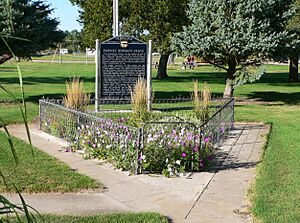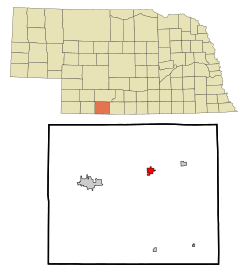Indianola, Nebraska facts for kids
Quick facts for kids
Indianola, Nebraska
|
|
|---|---|

Indianola town park: grave of Pawnee victim of Massacre Canyon event, September 2010
|
|

Location of Indianola, Nebraska
|
|
| Country | United States |
| State | Nebraska |
| County | Red Willow |
| Area | |
| • Total | 1.25 sq mi (3.23 km2) |
| • Land | 1.25 sq mi (3.23 km2) |
| • Water | 0.00 sq mi (0.00 km2) |
| Elevation | 2,382 ft (726 m) |
| Population
(2020)
|
|
| • Total | 524 |
| • Density | 419.87/sq mi (162.14/km2) |
| Time zone | UTC-6 (Central (CST)) |
| • Summer (DST) | UTC-5 (CDT) |
| ZIP code |
69034
|
| Area code(s) | 308 |
| FIPS code | 31-23830 |
| GNIS feature ID | 2395425 |
Indianola is a small village in Red Willow County, Nebraska, United States. In 2020, about 524 people lived there. It is a quiet place with an interesting past, especially linked to the early days of Nebraska.
Contents
History of Indianola
Indianola was officially planned and marked on a map in 1873. The community was named after Indianola, Iowa. This was the former hometown of one of the first people to settle here.
In its early days, Indianola was the main town, or "county seat," for Red Willow County. This meant important government offices were located here. However, a railroad company decided to build its main stop between Omaha and Denver in a different town called McCook. Because of this, the county seat was moved to McCook, and Indianola became a smaller town.
The Pawnee Grave Site
In the City Park of Indianola, you can find the grave of a Pawnee woman. She died from injuries she received during a battle between the Sioux and Pawnee tribes. This battle happened at Massacre Canyon, which is just east of Trenton.
The woman was first buried northwest of town on a bluff near Coon Creek. In the 1970s, it became clear that the grave site was being damaged by natural erosion. So, in 1975, she was reburied in the park. Members of the Pawnee tribe took part in the special ceremony.
Geography of Indianola
According to the United States Census Bureau, Indianola covers a total area of about 1.25 square miles (3.23 square kilometers). All of this area is land.
Population and People
| Historical population | |||
|---|---|---|---|
| Census | Pop. | %± | |
| 1880 | 233 | — | |
| 1890 | 579 | 148.5% | |
| 1900 | 626 | 8.1% | |
| 1910 | 681 | 8.8% | |
| 1920 | 742 | 9.0% | |
| 1930 | 815 | 9.8% | |
| 1940 | 800 | −1.8% | |
| 1950 | 738 | −7.7% | |
| 1960 | 754 | 2.2% | |
| 1970 | 672 | −10.9% | |
| 1980 | 856 | 27.4% | |
| 1990 | 672 | −21.5% | |
| 2000 | 642 | −4.5% | |
| 2010 | 584 | −9.0% | |
| 2020 | 524 | −10.3% | |
| U.S. Decennial Census | |||
Indianola's Population in 2010
Based on the census from 2010, there were 584 people living in Indianola. These people lived in 256 households, and 160 of these were families. The village had about 467 people per square mile (180 people per square kilometer).
Most of the people living in Indianola were White (98.1%). A small number were Native American (0.3%), Asian (0.2%), or from other backgrounds. About 1.5% of the population identified as Hispanic or Latino.
In terms of households, 27.7% had children under 18 living with them. About 52.3% were married couples living together. The average household had 2.28 people, and the average family had 2.92 people.
The average age of people in Indianola was 42.8 years old. About 24.7% of residents were under 18. Also, 15.9% were 65 years old or older. The population was almost evenly split between males (51.5%) and females (48.5%).
See also
 In Spanish: Indianola (Nebraska) para niños
In Spanish: Indianola (Nebraska) para niños

